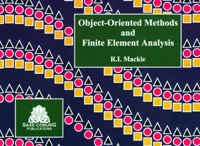

Books page

Object Oriented Methods and Finite Element Analysis by R.I. Mackie.
Saxe-Coburg Publications: ISBN 1-874672-08-3This book describes the advantages of object oriented programming for finite element software development. The book explains the overall design philosophy as well as providing the reader with detailed programming information. The OO approach to finite element programming requires a radically different approach from that used for traditional finite element programming. The book highlights the differences and demonstrates the advantages of the OO approach. Sufficient detailed programming information is included to help readers to implement their own OO code or adapt the ideas presented in the book.
The Scottish Chateau by Charles McKean
Sutton: ISBN 0 7509 2323 7
It has long been held that the Scottish chateaux, perhaps the best known of Scottish buildings, were castles, defensive strongholds built in a country where the Renaissance architecture was commonly believed to be somewhat backward. As Charles McKean demonstrates in this radical reassessment of the development of the country houses in Renaissance Scotland, the image of MacSavage which has dominated our view of the country's architecture during the period is more myth than truth. On the contrary, the architectural demands of a cultured nation participating in European ideas were satisfied by a flowering of domestic architecture that symbolised its status and growing sophistication. In these "castle-wise country houses" battlements were ornamental. Their gunloops essentially unusable, and their large gardens indefensible, while their owners lavished time and money on clothes and inventions, chivalry and flamboyant architectural devices.
Well researched, elegantly written and including a wealth of superb illustrations from a diverse range of sources, The Scottish Chateau provides a stimulating and enjoyable introduction to the nation's renaissance architecture for the general reader. It will also provoke widespread debate and a reassessment of the architecture of the period among scholars.
Nodulation in Legumes by Janet Sprent
Royal Botanic Gardens, Kew: ISBN 1 84246 013 7After a lifetime's research, Professor Emeritus Janet Sprent has published her long awaited study "Nodulation in Legumes" explaining the ability of legume plants to act as natural soil fertilisers by fixing nitrogen.
Janet hopes that her work will serve as a handbook for the developing world as she concludes that leguminous plants are vital for sustainability. Legumes can be grown in adverse environments including extreme temperatures and low nutrient soils. Forage, food and shelter are just some of the long term benefits they provide for both humans and animals. Professor Sprent: "Any country needs to assess its own ecosystem before deciding on a programme of sustainable development. I hope that my work will act as a reference, explaining the principles of sustainability and the role of legumes in that process. Costs of the book have been kept to a minimum to make it affordable in developing countries."
Next Page
Return to December 2001 Contact